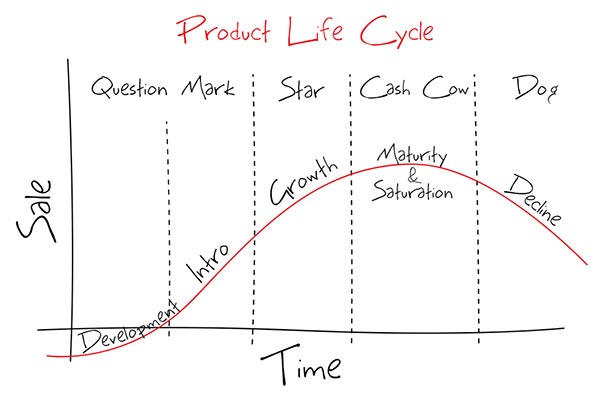Just as your business moves through stages of growth and development, products and services undergo a cycle of life from development to decline. Knowing where each of your products stands in the product/service lifecycle is crucial to the ongoing success of your business. Ignoring this process leads to a decline in sales and the loss of clients.

Defining the Product/Service Lifecycle
The lifecycle of your product and/or service is exactly as it sounds: the stages products and/or services undergo throughout their lifetime. These stages are introduction, growth, maturity, and decline. Each stage requires different actions and produces different results. In the end, you’re left with a product that either continues to be relevant in the market, or one that must be phased out due to technological advances or changes in consumer demand.
Consider typewriters, for example. This is a product that was rendered unnecessary with the invention of the personal computer. Similarly, cassette tapes were replaced with CDs, and now CDs are being replaced by MP3s.
Unfortunately, some products aren’t adaptable with advances in technology, and will eventually become obsolete. Other products or services, though, have the ability to be re-marketed or redesigned in order to continue meeting consumers’ needs. Knowing where your products stand in their lifecycle is the first step toward ensuring they maintain their longevity in the marketplace.
Stages of the Product/Service Lifecycle
From development to decline, each stage of the product/service lifecycle requires different actions. Take a look at the stages below.
- Introduction. During this stage, you don’t make much money due to high development and marketing costs, even though your price is at its highest. To offset costs and begin bringing in a profit as quickly as possible, invest sufficient funds into a marketing campaign and distribution channels to raise awareness about the new product or service. Additionally, watch the market carefully and experiment with various configurations to determine what works best. Once you notice product demand and sales increasing, you know you’re entering the next lifecycle stage.
- Growth. This is the phase in which profits are highest and your cash flow improves. Don’t make the mistake of getting too comfortable, though. You need to continue to make refinements and enhance development capabilities in order to stay ahead of the competition. When you see your sales trend stabilizing, you’re headed to the next stage in the lifecycle.
- Maturity. During this stage, profits generally decrease, even though sales are stable. This is because prices repeatedly drop in order to compete in the marketplace. That said, sales continue to create sufficient cash flow for your business. It’s crucial during this time to conduct market research, invest in development, and adapt your products and/or services to meet changing consumer needs. Failing to take these actions causes you to be left with products and services that are no longer relevant, and don’t sell.
- Decline. While this is the end of the product/service lifecycle, there’s a chance for you to begin the cycle over with your products or services if you’ve taken the appropriate steps during the maturity stage. Invest in a new marketing campaign, address any issues with the product or service, or consider a regeneration strategy (for example, newspapers going from print publications to online publications).
Those companies who carefully analyze the lifecycle of their products and/or services are more likely to continue having a major presence in an ever-changing market. Those who don’t, however, may find themselves struggling just to keep their doors open. Consider following the advice mentioned in each lifecycle stage, and you’ll be on your way to continued market relevance and business growth.
Think your products and/or services might be in need of a nip tuck? Contact us today. We stand at the ready to keep your business relevant and growing.

